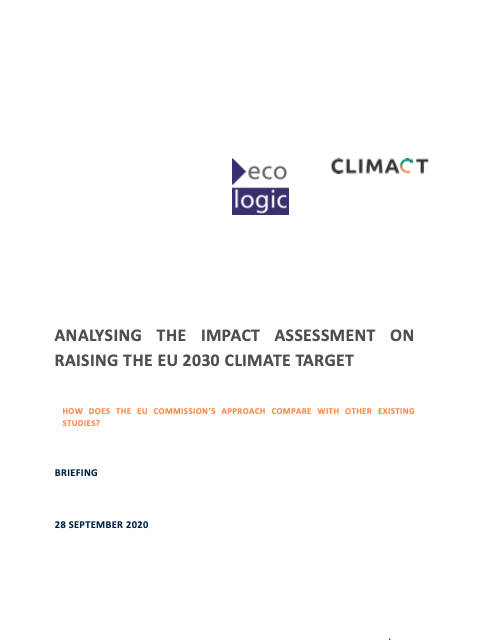Analysing the Impact Assessment on Raising the EU 2030 Climate Target
How does the European Commission's approach compare with other existing studies?
- Publication
- Citation
Climact, Ecologic Institute (2020): Analysing the impact assessment on raIsing the EU 2030 climate target - How does the European Commission’s approach compare with other existing studies?
On 17 September 2020, the European Commission proposed to raise the EU climate target for 2030, so as to reduce greenhouse gas emissions by 55% compared to 1990. In this policy brief, CLIMACT and Ecologic Institute unpack the Commission's impact assessment for the new target. The brief analyses key policy options and analytical results and compares them to recent studies, in particular CLIMACT's 2030 modelling results. Within the framework of the tightened target, the EU Commission proposes to extend the EU Emissions Trading Scheme to buildings and road transport – a major change to the EU's current climate policy architecture. The team discusses potential implications and provides context to the sectoral developments and policies. The briefing highlights key points where the Commission diverges from other studies, identifying climate mitigation potentials that merit more attention in future analysis.
Key findings include:
- While proposing to explore the extension of the EU Emissions Trading Scheme, the Commission recognises the need for strengthening regulation at the same time. This is in line with extensive scientific evidence on the strengths of policy mixes compared to a pure pricing approach.
- A policy mix of extending carbon pricing and keeping the Effort Sharing Regulation in place is warranted from a risk management perspective. Setting up a functioning carbon pricing mechanism will be challenging, time-consuming and politically sensitive. As long as a carbon pricing scheme for road transport and buildings emissions is not in place and has not proven to effectively cap total emissions, it would be extremely risky to toss out the functioning system of compliance control that is the Effort Sharing Regulation. Even in the longer run, there is an argument for keeping national targets for transport and buildings in place. It would ensure that national governments implement climate policies that address the transformation to climate neutrality as a systemic challenge, supporting private actors in their mitigation efforts, e.g. by rolling out infrastructure and creating an enabling regulatory framework.
- As for the concrete policy levers included in the scenarios, our findings suggest that some key avenues are missing and must be explored further. The scenarios used in the Impact Assessment tend to be technology-oriented without addressing the impact of potential societal changes. A true vision for a circular economy by 2030 is missing.
- On the other hand, the technical ambition at the sectoral level in the EU Impact Assessment must be praised, the scenarios explore a real change in the scale of ambition, particularly with respect to renewable energy built-up and energy efficiency improvements.





